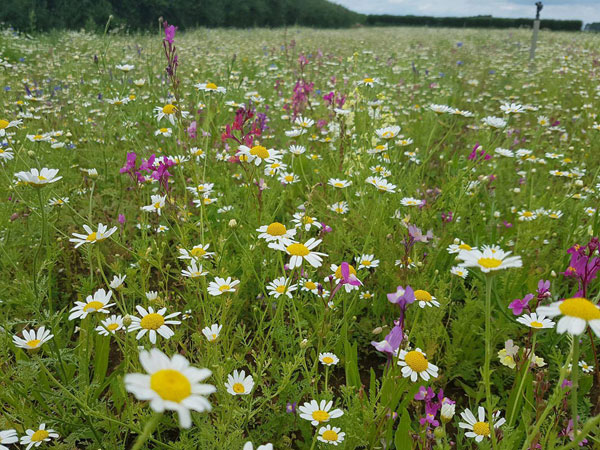Wild Flower Turf – Birds & Bees Mix
*Subject to season and availability
We’ve put together a mix of 41 native British wildflowers that will encourage a wide variety of wildlife into your garden.
Besides being a joy to share your space with, Garden Birds and Bees Meadowmat has many features to actively support biodiversity.
- A long flowering period. Which means that it supplies pollen and nectar for bees, butterflies, hoverflies and moths all through the spring and summer months and well into autumn too.
- Source of food for caterpillars and therefore a vital part of butterfly and moth life cycles.
- Autumn seed heads and a ready supply of insects and larvae for birds.
- For the human visitors to your garden there are colourful flowers and the fascination of watching wild creatures going about their everyday life.
Please Enquire for prices and availability
Please call 01872 870904 to place your order
What is Meadowmat?
If you’re not familiar with Meadowmat, it’s an innovative landscaping material that allows you to establish dense planting very quickly. More reliable than seeding and less time consuming than plugplanting, Meadowmat can only be described as a flower garden on a roll. It’s installed and established just like grass turf but needs less ongoing maintenance than a lawn.
Maintaining Traditional Meadowmat requires a different approach to any other type of gardening. Fertilisers and pesticides can stay in the shed – you won’t be needing those. Neither will you need your lawn mower. Meadowmat can be left to grow unchecked between March and August. At the end of summer it is cut back to a height of 10 – 15 cm and all vegetation is removed. Mow once or twice in autumn to remove excess growth and leave over winter and your Traditional Meadowmat will naturally start growing when the soils warm up in spring.
For more detailed information on installing and maintaining Tradtional Meadowmat please visit the blog and the knowledgebase sections of our website.
Key Points
- The majority of plant species in Traditional Meadowmat are perennial. That means that if they are happy in your garden they will grow back year after year.
- Flowering Time: May – July (depending on local weather conditions).
- Meadowmat is mown before despatch to minimise damage to plants. It will not be in flower when it is delivered.
- For flowers in its first season, install Traditional Meadowmat before the end of march to allow plants to establish.
- A standard roll of Traditional Meadowmat covers 1 square metre of prepared soil and weights up to 25Kg. We recommend having two people to install it.
- The balance of plant species is affected by soil type, management, pollinator populations and local climatic conditions. Your Traditional Meadowmat will change appearance from year to year, which is one of the reasons we love it so much.
What’s In Garden Birds and Bees Meadowmat?
Please note, percentages refer to the weight of the seed in the growing mix and do not necessarily reflect the proportions of mature plants.
100% native wildflowers
For a colourful display that provides lots of pollen and nectar to support beneficial insects all the way from early spring to late autumn.
For more information about each flower, click on the article below
- Agrimony
- Autumn hawkbit
- Birdsfoot trefoil
- Bladder Campion
- Chicory
- Clustered bellflower
- Columbine
- Common mallow
- Common sorrel
- Common toadflax
- Cornflower
- Daisy
- Fennel
- Field poppy
- Fox and Cubs
- Foxglove
- Grandmothers Garden
- Greater Knapweed
- Harebell
- Maiden pink
- Meadow buttercup
- Meadow cranes-bill
- Musk mallow
- Purple loosestrife
- Ragged robin
- Red campion
- Red clover
- Sheeps bit
- Small scabious
- Tansy
- Teasel
- Viper’s bugloss
- White campion
- White clover
- Wild Basil
- Wild carrot
- Wild clary
- Wild marjoram
- Wild pansy
- Wild thyme
- Yarrow

